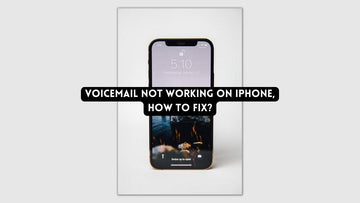How to Securely Use AirDrop on Your iPhone and iPad?
by Chelsea Bruhl on Sep 26, 2024

While AirDrop can be a convenient tool, it can also pose security risks if not used properly. Cyber criminals can exploit vulnerabilities in AirDrop to gain access to your device or steal your personal information.
Therefore, it's important to take steps to secure your AirDrop settings to protect your privacy and security.
In this article, I'll provide practical tips and guidelines for securely using AirDrop on your iPhone and iPad.
In order for you to securely use AirDrop on your iPhone and iPad , it's important to turn off the feature when not in use by accessing the Control Center and turning the feature off by pressing the network settings box and tapping on "Receiving Off". Apart from this you can also try sharing only with trusted contacts, renaming your device to avoid revealing personal information, keeping your device up to date with the latest software updates and enabling password protection for your iPhone or iPad.
How to Securely Use AirDrop on Your iPhone and iPad
It's important to use AirDrop securely to protect your privacy and prevent unauthorized access to your device.
Here's what you can do to secure your data while using AirDrop.
Turn off AirDrop when not in use
The first and most important tip is to turn off AirDrop when you're not using it. This prevents your device from being discoverable to nearby devices and reduces the risk of unauthorized access.

To turn off AirDrop, swipe down from the top right corner of the screen to open Control Center, press and hold the network settings box, and select "Receiving Off."
Use AirDrop only with people you trust
While AirDrop is a convenient and efficient way to share files, it is important to use it only with people you trust because of the following reasons:
- If you AirDrop files with someone you don't trust, they may send you files containing malware or viruses that could damage your device or compromise your personal information.
- When you AirDrop files with someone, you are giving them access to your device's name and potentially other information, depending on how your AirDrop settings are configured. If you AirDrop files with someone you don't trust, they could potentially use this information for nefarious purposes.
- If you AirDrop files with someone you don't trust, they may send you unwanted or inappropriate content that could make you feel uncomfortable or violated.

You can choose to share with contacts only, or set your AirDrop receiving setting to "Contacts Only" or "Everyone" depending on your needs.
Rename your device
By default, your iPhone or iPad's name is used as the AirDrop identifier, which can reveal personal information about you.

To protect your privacy, consider renaming your device to a generic name or nickname that doesn't reveal any personal information.
You can change your device name by going to Settings > General > About > Name.
Keep your device up to date
Keeping your device up to date with the latest software updates is important for security reasons.
Apple regularly releases updates that fix security vulnerabilities and bugs, so make sure to update your device as soon as a new update is available.

To update your iPhone or iPad;
- Connect your iPhone or iPad to a power source or make sure it has enough battery life to complete the update process.
- Connect your device to the internet. You can connect via Wi-Fi or cellular data.
- On your device, go to the Settings app.
- Tap on "General" and then select "Software Update."
- Your device will then check for any available updates.
- If an update is available, tap "Download and Install."
- You may be asked to enter your passcode or agree to some terms and conditions before proceeding with the update.
- The update will then start downloading. This may take some time depending on the size of the update and your internet connection.
- Once the download is complete, your device will automatically start installing the update.
Turn on password protection
To add an extra layer of security to your device, make sure to enable password protection. This prevents unauthorized access to your device in case it falls into the wrong hands.

You can enable password protection by going to Settings > Face ID & Passcode (or Touch ID & Passcode for older devices).
Use a VPN
Using a VPN (Virtual Private Network) is a good way to protect your device and data from potential threats when using AirDrop in public places or on unsecured Wi-Fi networks.

A VPN encrypts your internet traffic, making it difficult for hackers to intercept your data. You can set up a VPN on your device by going to Settings > General > VPN.
Be careful with what you share
Finally, it's important to be careful with what you share over AirDrop.
Avoid sharing sensitive or confidential information, such as bank account details or personal identification documents, over AirDrop.
Instead, use a more secure method such as encrypted email or a password-protected cloud service.
What is AirDrop and What are its Limitations
AirDrop is a file-sharing feature developed by Apple that allows users to quickly and easily share files between Apple devices using Wi-Fi and Bluetooth.
AirDrop uses a combination of peer-to-peer Wi-Fi and Bluetooth connections to transfer files securely and quickly between Apple devices.
Supported Devices and OS Versions
AirDrop is available on the following Apple devices:
- iPhone 5 or later
- iPad 4th generation or later
- iPad mini or later
- iPod touch 5th generation or later
- Macs running OS X Yosemite (10.10) or later
AirDrop Limitations
Although AirDrop is a convenient way to share files between Apple devices, it has some limitations:
- AirDrop only works between Apple devices that are in close proximity to each other, typically within 30 feet or so.
- Both devices must have Wi-Fi and Bluetooth turned on.
- AirDrop is only compatible with certain file types, such as photos, videos, documents, and contacts.
- AirDrop does not work with non-Apple devices.
How to Check Device Compatibility

To check if your Apple device is compatible with AirDrop, follow these steps:
- Open Control Center by swiping down from the top right corner of your iPhone or iPad screen, or up from the bottom of your Mac screen.
- Look for the AirDrop icon in Control Center.
- If you see it, your device is compatible with AirDrop.
- If you don't see the AirDrop icon, your device may not be compatible with AirDrop, or AirDrop may not be turned on.
- You can turn on AirDrop by going to Settings > General > AirDrop on iOS devices, or by opening Finder on a Mac and clicking on AirDrop in the sidebar.
What are the risks and vulnerabilities associated with AirDrop
While it can be a convenient way to share photos, documents, and other files with friends and colleagues, it also comes with some risks and vulnerabilities that users should be aware of.
- One of the main risks of using AirDrop is that it can potentially expose your device to hackers or malicious actors.
- Since AirDrop relies on Bluetooth and Wi-Fi signals to connect with nearby devices, anyone within range of your device could potentially try to connect to it and access your files.
- This is particularly concerning in public places like airports, coffee shops, or other crowded areas where there may be many people with malicious intent.
- Another vulnerability of AirDrop is that it can be used to distribute malware or other malicious software.
- Hackers can use AirDrop to send infected files to unsuspecting users, who may then inadvertently download and install the malware on their device.
- This could lead to a wide range of security issues, including data theft, identity theft, and other forms of cyber crime.
In addition to these risks, there are also privacy concerns associated with AirDrop.
- When you use AirDrop, your device sends out a signal that can be detected by other nearby devices.
- This signal contains information about your device, including its name, model, and operating system.
- This information could potentially be used by hackers or other malicious actors to track your device or identify vulnerabilities that they could exploit.
Troubleshooting common AirDrop issues
AirDrop is not working at all

If AirDrop is not working on your device, first make sure that both Wi-Fi and Bluetooth are turned on. If they are on and AirDrop still doesn't work, try restarting both devices.
If the problem persists, try resetting the network settings on both devices by going to Settings > General > Reset > Reset Network Settings. You may also want to try disabling and re-enabling AirDrop on both devices.
Unable to find the recipient's device

If you can't find the recipient's device when you try to use AirDrop, make sure that both devices are within range and have AirDrop turned on.
Also, make sure that the recipient's device is discoverable by setting their AirDrop visibility to "Everyone" in the AirDrop settings.
If the recipient still doesn't appear, try restarting both devices and see if that helps.
File transfer fails
If the file transfer fails when using AirDrop, check to make sure that the file is not too large.
AirDrop has a file size limit of 5GB, so if the file is larger than that, you will need to use a different method to transfer the file.
Also, make sure that both devices have enough storage space to receive the file. If the file is still failing to transfer, try restarting both devices and see if that helps.
AirDrop is not available on older devices
AirDrop requires certain hardware and software capabilities, so it may not be available on older devices.
For example, AirDrop requires an iPhone 5 or later, a fourth-generation iPad or later, an iPad mini or later, or a fifth-generation iPod touch or later.
Also, AirDrop requires at least iOS 7 or later on iPhone, iPad, or iPod touch, or OS X Yosemite or later on a Mac.
AirDrop is not available on the recipient's device
If AirDrop is not available on the recipient's device, make sure that their device meets the requirements mentioned above.
Also, some older devices may not have AirDrop available even if they meet the requirements. In this case, you will need to use a different method to transfer the file.
Conclusion
By following the guidelines mentioned in this guide, you can take necessary steps to ensure that your AirDrop experience is secure and private.
Always make sure to set your AirDrop to "Contacts Only" or "Off" to avoid receiving unsolicited files from unknown sources.
Additionally, verify the identity of the sender and never accept files from unfamiliar sources.
By being vigilant and following these tips, you can safely and securely use AirDrop for all your file-sharing needs.
Related





